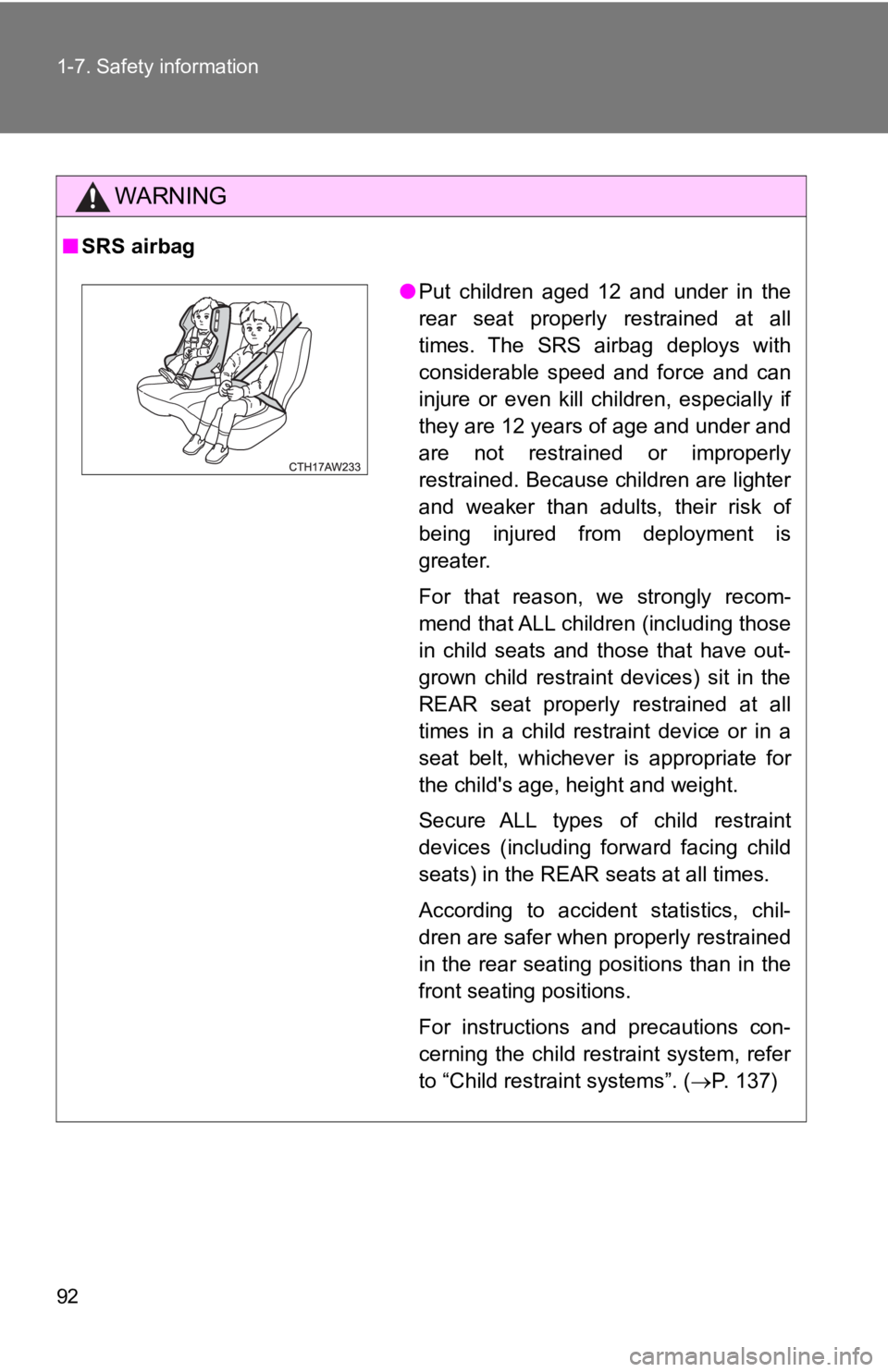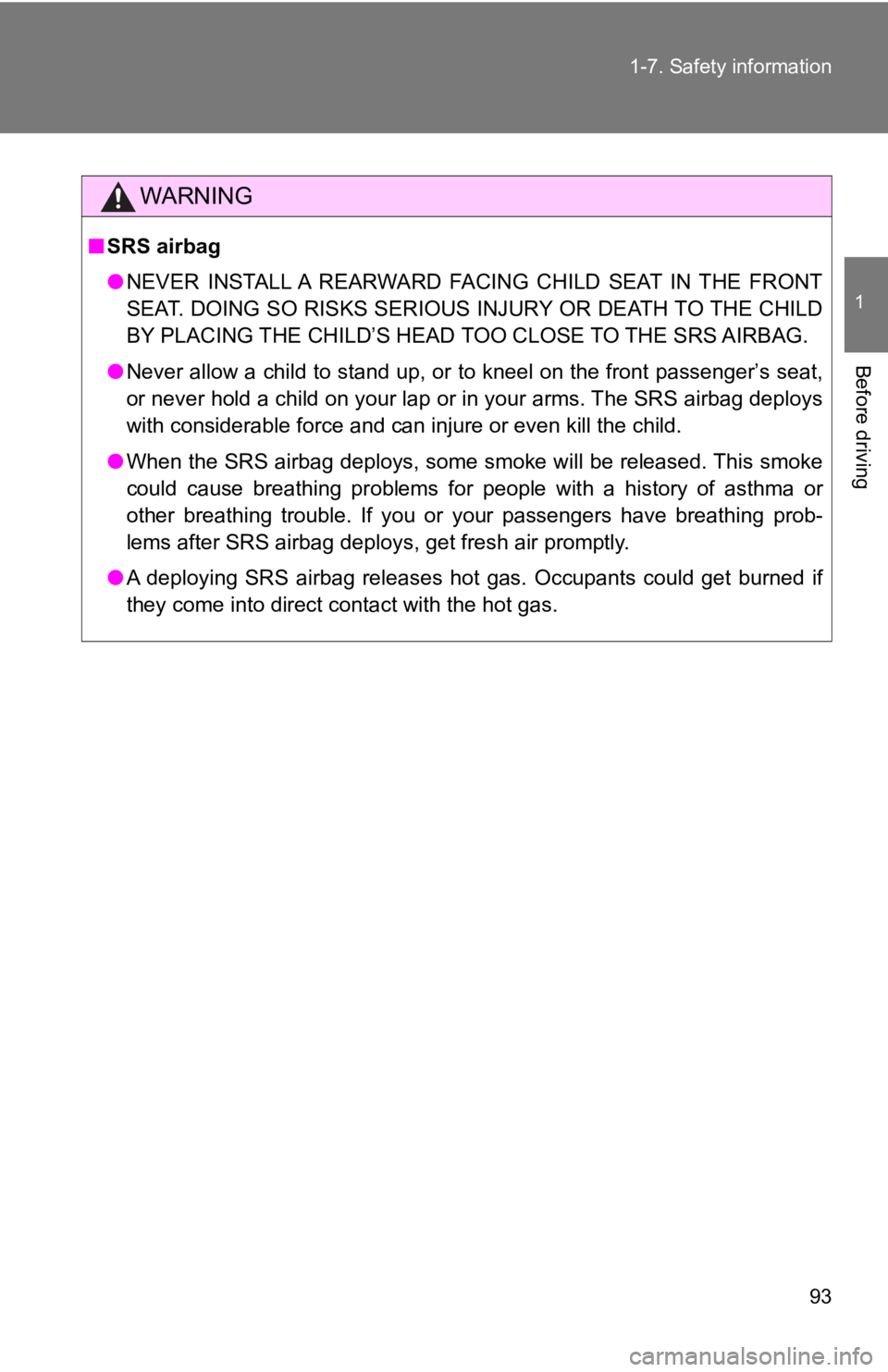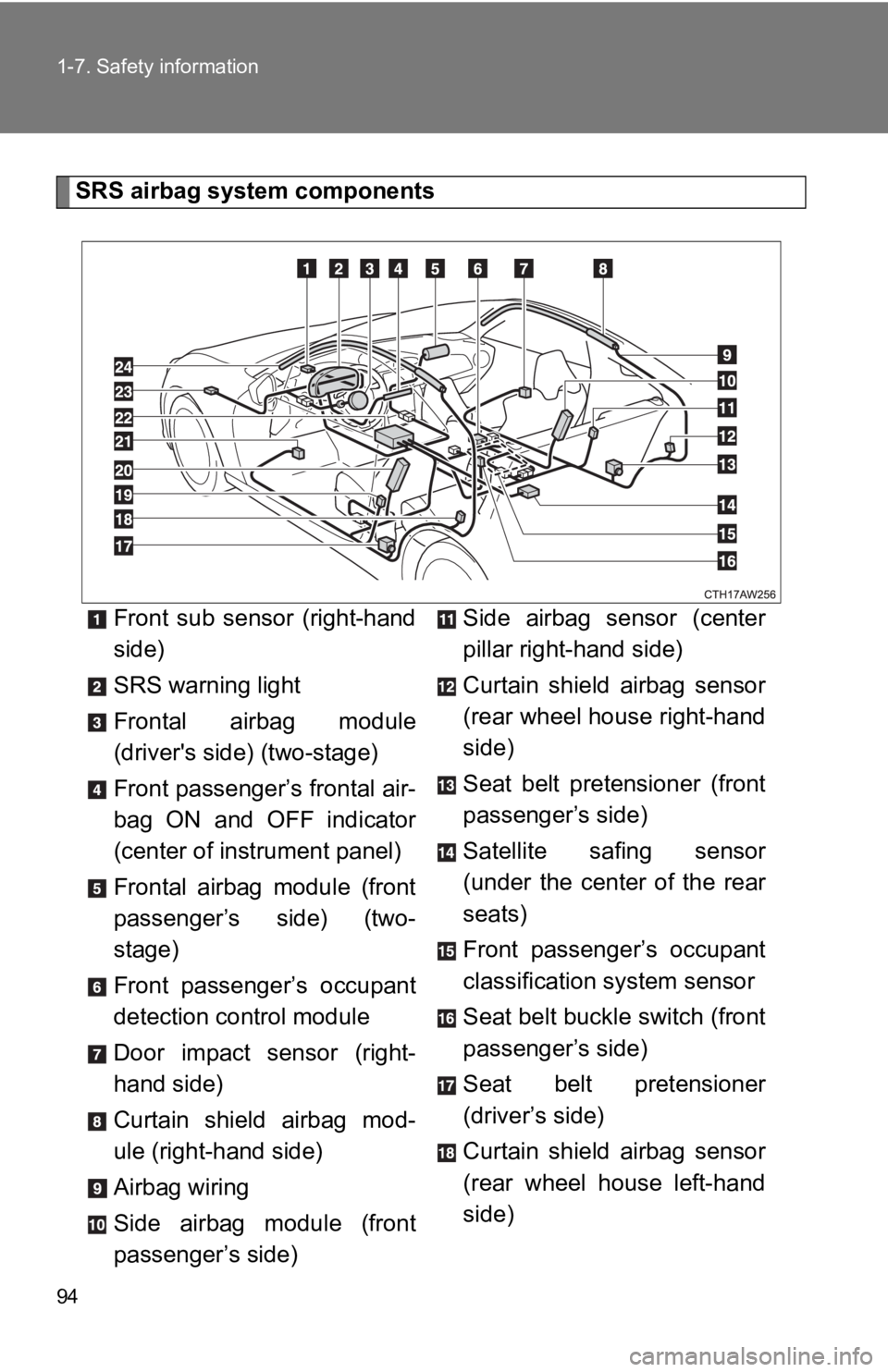2019 TOYOTA 86 warning
[x] Cancel search: warningPage 80 of 532

801-6. Theft det errent system
■ When the vehicle cannot be star ted with the registered key (veh icles
without a smart key system)
Remove the key and try again.
■ System maintenance
The vehicle has a maintenance-free type engine immobilizer syst em.
■ Conditions that may cause the system to malfunction
● If the key is in contact with a metallic object
● If the key is in close proximity to or touching a key to the security system
(key with a built-in transponder chip) of another vehicle
■ Certification for engine immob ilizer system (vehicles without a smart
key system)
For vehicles sold in the U.S.A.
FCC ID: MOZRI-38BFH
This device complies with part 15 of the FCC Rules. Operation i s subject to
the following two conditions: (1) This device may not cause har mful interfer-
ence, and (2) this device must accept any interference received, including
interference that may cause undesired operation.
FCC WARNING
Changes or modifications not expressly approved by the party re sponsible
for compliance could void the user’s authority to operate the e quipment.
For vehicles sold in Canada
NOTE:
This device complies with Industry Canada’s licence-exempt RSSs . Opera-
tion is subject to the following two conditions: (1) This devic e may not cause
interference; and (2) This device must accept any interference, including
interference that may cause undesired operation of the device.
NOTE:
Le présent appareil est conforme aux CNR d’Industrie Canada app licables
aux appareils radio exempts de licence. L’exploitation est auto risée aux
deux conditions suivantes: (1) l’appareil ne doit pas produire de brouillage;
(2) l’utilisateur de l’appareil doit accepter tout brouillage r adioélectrique subi,
même si le brouillage est susceptible d’en compromettre le fonc tionnement.
Page 81 of 532

811-6. Theft deterrent system
1
Before driving ■ Certification for engine immobilizer system (vehicles with a sm art key
system)
For vehicles sold in the U.S.A.
FCC ID: Y8PSSPIMB03
This device complies with part 15 of the FCC Rules. Operation i s subject to
the following two conditions: (1) This device may not cause har mful interfer-
ence, and (2) this device must accept any interference received, including
interference that may cause undesired operation.
FCC WARNING
Changes or modifications not expressly approved by the party re sponsible
for compliance could void the user’s authority to operate the e quipment.
For vehicles sold in Canada
NOTE:
This device complies with Industry Canada’s licence-exempt RSSs . Opera-
tion is subject to the following two conditions: (1) This devic e may not cause
interference; and (2) This device must accept any interference, including
interference that may cause undesired operation of the device.
NOTE:
Le présent appareil est conforme aux CNR d’Industrie Canada app licables
aux appareils radio exempts de licence. L’exploitation est auto risée aux
deux conditions suivantes: (1) l’appareil ne doit pas produire de brouillage;
(2) l’utilisateur de l’appareil doit accepter tout brouillage r adioélectrique subi,
même si le brouillage est susceptible d’en compromettre le fonc tionnement.
NOTICE
■ To ensure the system operates correctly
Do not modify or remove the system. If modified or removed, the proper
operation of the system cannot be guaranteed.
Page 88 of 532

881-7. Safety information
WARNING■ While driving
● Do not adjust the position of the driver's seat.
Doing so could cause the driver to lose control of the vehicle.
● Do not place a cushion between the driver or passenger and the seatback.
A cushion may prevent correct posture from being achieved, and reduce
the effectiveness of the seat belt and head restraint, increasing the risk of
death or serious injury to the driver or passenger.
● Do not place anything under the front seats.
Objects placed under the front seats may become jammed in the s eat
tracks and stop the seat from locking in place. This may lead t o an acci-
dent resulting in serious injury or death. The adjustment mecha nism may
also be damaged.
■ Adjusting the seat position
● Take care when adjusting the seat position to ensure that other passen-
gers are not injured by the moving seat.
● Do not put your hands under the seat or near the moving parts t o avoid
injury.
Fingers or hands may become jammed in the seat mechanism.
Page 91 of 532

911-7. Safety information
1
Before driving WARNING■ SRS airbag
● To obtain maximum protection in the event of an accident, the d river and
all passengers in the vehicle should always wear seat belts whe n the vehi-
cle is moving. The SRS airbag is designed only to be a suppleme nt to the
primary protection provided by the seat belt. It does not elimi nate the need
to fasten seat belts. In combination with the seat belts, it of fers the best
combined protection in case of a serious accident.
Not wearing a seat belt increases the chance of severe injury o r death in a
crash even when the vehicle has the SRS airbag.
For instructions and precautions concerning the seat belt syste m, refer to
“Seat belts”. ( P. 60)
● Do not sit or lean unnecessarily close to the SRS airbag. Becau se the
SRS airbag deploys with considerable speed - faster than the bl ink of an
eye - and force to protect in high speed collisions, the force of an airbag
can injure an occupant whose body is too close to SRS airbag.
It is also important to wear your seat belt to help avoid injur ies that can
result when the SRS airbag contacts an occupant not in proper p osition
such as one thrown forward during pre-accident braking.
Even when properly positioned, there remains a possibility that an occu-
pant may suffer minor injury such as abrasions and bruises to t he face or
arms because of the SRS airbag deployment force.
● The SRS airbags deploy with considerable speed and force. Occup ants
who are out of proper position when the SRS airbag deploys could suffer
very serious injuries. Because the SRS airbag needs enough spac e for
deployment, the driver should always sit upright and well back in the seat
as far from the steering wheel as practical while still maintai ning full vehi-
cle control and the front passenger should move the seat as far back as
possible and sit upright and well back in the seat.
● Do not place any objects over or near the SRS airbag cover or b etween
you and the SRS airbag. If the SRS airbag deploys, those object s could
interfere with its proper operation and could be propelled insi de the vehicle
and cause injury.
Page 92 of 532

921-7. Safety information
WARNING■ SRS airbag
● Put children aged 12 and under in the
rear seat properly restrained at all
times. The SRS airbag deploys with
considerable speed and force and can
injure or even kill children, especially if
they are 12 years of age and under and
are not restrained or improperly
restrained. Because children are lighter
and weaker than adults, their risk of
being injured from deployment is
greater.
For that reason, we strongly recom-
mend that ALL children (including those
in child seats and those that have out-
grown child restraint devices) sit in the
REAR seat properly restrained at all
times in a child restraint device or in a
seat belt, whichever is appropriate for
the child's age, height and weight.
Secure ALL types of child restraint
devices (including forward facing child
seats) in the REAR seats at all times.
According to accident statistics, chil-
dren are safer when properly restrained
in the rear seating positions than in the
front seating positions.
For instructions and precautions con-
cerning the child restraint system, refer
to “Child restraint systems”. ( P. 137)
Page 93 of 532

931-7. Safety information
1
Before driving WARNING■ SRS airbag
● NEVER INSTALL A REARWARD FACING CHILD SEAT IN THE FRONT
SEAT. DOING SO RISKS SERIOUS INJURY OR DEATH TO THE CHILD
BY PLACING THE CHILD’S HEAD TOO CLOSE TO THE SRS AIRBAG.
● Never allow a child to stand up, or to kneel on the front passe nger’s seat,
or never hold a child on your lap or in your arms. The SRS airb ag deploys
with considerable force and can injure or even kill the child.
● When the SRS airbag deploys, some smoke will be released. This smoke
could cause breathing problems for people with a history of asthma or
other breathing trouble. If you or your passengers have breathi ng prob-
lems after SRS airbag deploys, get fresh air promptly.
● A deploying SRS airbag releases hot gas. Occupants could get bu rned if
they come into direct contact with the hot gas.
Page 94 of 532

941-7. Safety information
SRS airbag system components
Front sub sensor (right-hand
side)
SRS warning light
Frontal airbag module
(driver's side) (two-stage)
Front passenger’s frontal air-
bag ON and OFF indicator
(center of instrument panel)
Frontal airbag module (front
passenger’s side) (two-
stage)
Front passenger’s occupant
detection control module
Door impact sensor (right-
hand side)
Curtain shield airbag mod-
ule (right-hand side)
Airbag wiring
Side airbag module (front
passenger’s side) Side airbag sensor (center
pillar right-hand side)
Curtain shield airbag sensor
(rear wheel house right-hand
side)
Seat belt pretensioner (front
passenger’s side)
Satellite safing sensor
(under the center of the rear
seats)
Front passenger’s occupant
classification system sensor
Seat belt buckle switch (front
passenger’s side)
Seat belt pretensioner
(driver’s side)
Curtain shield airbag sensor
(rear wheel house left-hand
side)
Page 96 of 532

961-7. Safety information
Toyota advanced frontal airbag system
Your vehicle is equipped with a Toyota advanced frontal airbag sys-
tem that complies with the new advanced frontal airbag requirem ents
in the amended Federal Motor Vehicle Safety Standard (FMVSS) No .
208.
The Toyota advanced frontal airbag system automatically determi nes
the deployment force of the driv er’s SRS frontal airbag at the time of
deployment as well as whether or not to activate the front pass en-
ger’s SRS frontal airbag and, if activated, the deployment forc e of the
SRS frontal airbag at the time of deployment.
Your vehicle has warning labels on the driver’s and front passe nger’s
sun visors beginning with the phrase “EVEN WITH ADVANCED AIR
BAGS” and a tag attached to the glove box lid beginning with th e
phrase “Even with Advanced Air Bags”. Make sure that you carefu lly
read the instructions on the warning labels and tag.
Always wear your seat belt. The Toyota advanced frontal airbag sys-
tem is a supplemental restraint system and must be used in comb ina-
tion with a seat belt. All occupa nts should wear a seat belt or be
seated in an appropriate c hild restraint system.
The driver’s SRS frontal airbag is stowed in the center portion of the
steering wheel. The front passenger’s SRS frontal airbag is sto wed
near the top of the dashboard under an “SRS AIRBAG” mark.
In a moderate to severe frontal collision, the following compon ents
deploy.
● SRS frontal airbag for driver
● SRS frontal airbag for front passenger
These components suppl ement the seat belts b y reducing the impa ct
to the occupant’s head and chest.